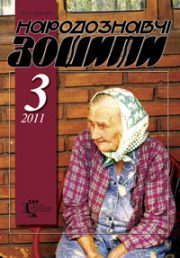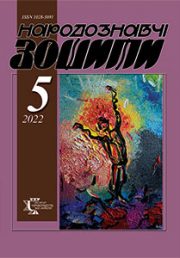The Ethnology Notebooks. 2022. № 6 (168), 1404—1418
UDK [7.05:[2-525.4/.7:746.3/.4]](477)”1990/2020″
DOI https://doi.org/10.15407/nz2022.06.1404
DESIGN PRACTICE IN UKRAINIAN CHURCH FABRICS (MANUFACTURING, ARTISTIC AND STYLE FEATURES)
OLIYNYK Olha
- ORCID ID: https://orcid.org/0000-0002-7292-3264
- Сandidate of Аrts (Ph. D),
- Researcher at the Folk Art Department
- of Ethnology Institute
- of the National Academy of Sciences of Ukraine,
- 15, Svobody Avenue, 79000, Lviv, Ukraine,
- Contacts: e-mail: oliao1610mac@gmail.com
Abstract. In the late 1990s in parallel with the usual author’s artistic practices in Ukrainian church fabrics, design appears — artistic decoration of products intended for further replication. The peculiarity of the design of canonical products is that this process must necessarily take into account the observance of church prescriptions, the semiotics of clothing and national traditions.
Design practice is represented in Ukraine by a number of specialized secular enterprises and numerous monastic machine embroidery workshops. This study analyzed the products of workshops from Kyiv, Lviv, Rivne, Kropyvnytskyi, Lutsk, and Volhynia regions. Today, the artistic concept of church fabrics is determined by tradition, the worldview principles of the contemporary and the possibilities of technology with software.
Article purpose — is to highlight the peculiarities of the application of design practice in the field of modern church textiles in Ukraine, to investigate sources of inspiration and trends in the development of artistic forms.
The object of the research are replicated products — church fabrics and canonical clothes of clergy from monastery workshops and industrial enterprises of Ukraine, and the subject is the specifics of the application of design practice in the field of modern Ukrainian church textiles.
The article source base there are scientific literature, materials of Internet sites of Ukrainian spiritual institutions and companies producing church textiles.
The method of systematic analysis of the artistic phenomenon — formal-stylistic, iconographic, comparative — were applied in the study.
The analysis of traditional and modern experience in the field of church textiles gives reasons to single out the main requirements for the development of the design of liturgical fabrics: artistic expressiveness, interpretation, associative image, a combination of centuries-old experience of liturgical sewing and the latest technologies. In the 21st century, designers, based on tradition (citation, reconstruction, interpretation and stylization), are busy searching for an artistic language to build a new aesthetic reality.
Textile attributes for the needs of the dominant denominations of the Ukrainian Church reveal certain differences in the choice of national-spiritual priorities and artistic-stylistic features, which is determined by the ideological and canonical foundations of the confessional confrontation in Ukrainian Orthodoxy (OCU and UOC MP).
Keywords: design, church fabrics, priestly vestments, monastery workshops, embroidery, decor, stylistics, face sewing, ornament.
Received 4.10.2022
REFERENCES
- Voropayeva, T. (2011). Dynamics of the development of national and religious identity of citizens of Ukraine (1991—2011). Orthodoxy in Ukraine (Pp. 135—145). Collection of materials of the All-Ukrainian scientific conference. Kyiv: Orthodox Theological Academy [in Ukrainian].
- Marynovich, M. (1999). The problem of preserving religious identity in the conditions of an open society. Civil society as an exercise of freedom: Central and Eastern European experience (Pp. 219—224). Lviv [in Ukrainian].
- Devochkina, O. Design is not art. Retrieved from: http://tutdesign.ru/cats/art/2408-dizayn-eto-ne-iskusstvo.html (Last accessed: 5.11.2021) [in Russian].
- Malinovsky, V.I. (2007). Improvement of the design process of canonical clothes of complex shape. Author. thesis Ph. D. Kyiv: National University of Technology and Design [in Ukrainian].
- Andrievska, M.O. (2015). Holy Resurrection Trinity Koretsky stauropigial women’s monastery. Gold sewing workshop. Church — science — society: issues of interaction (Pp. 39—41). In honor of Metropolitan Yevhenii (Bolkhovitinov) of Kyiv. Proceedings of the Thirteenth International Scientific Conference (May 27—29, 2015). Kyiv [in Ukrainian].
- Svyatogorsky Dormitionsky Zimnensky stauropygial monastery in Volyn. Sewing and gold sewing workshops. Retrieved from: http://zymne.org/shveina-ta-zotoloshveina-maisterni (Last accessed: 15.09.2022) [in Ukrainian].
- Textile and sewing enterprise «UPTS-TEXTIL». Retrieved from: https://upctextil.com/ua/ (Last accessed: 15.09.2022) [in Ukrainian].
- Golden stitching. Art and production enterprise. Retrieved from: https://zolotoe-shitvo.kr.ua (Last accessed: 15.09.2022) [in Ukrainian].
- Gold sewing, Foreign enterprise. UA-Region. Catalog of enterprises of Ukraine. Retrieved from: https://www.ua-region.com.ua/37796026. (Last accessed: 15.09.2022) [in Ukrainian].
- Art and production enterprise LZOLOTE SHITVO» PE «YERKIR». Retrieved from: https://who-is-who.ua/main/page/yuvilyars2009/73/385 (Last accessed: 15.09.2022) [in Ukrainian].
- Church workshop «Pokrov». Retrieved from: https://pokrove.com/ua/ (Last accessed: 15.09.2022) [in Ukrainian].
- FELON is an online store of church embroidered products. Retrieved from: https://felon.com.ua/catalogue/ (Last accessed: 15.09.2022) [in Ukrainian].
- Trikiriy church workshop. Retrieved from: https://cerkovna-utvar.com/ (Last accessed: 15.09.2022) [in Ukrainian].
- Church shop-workshop «Riza». Retrieved from: http://www.ryza.com.ua/ (Last accessed: 15.09.2022) [in Ukrainian].






